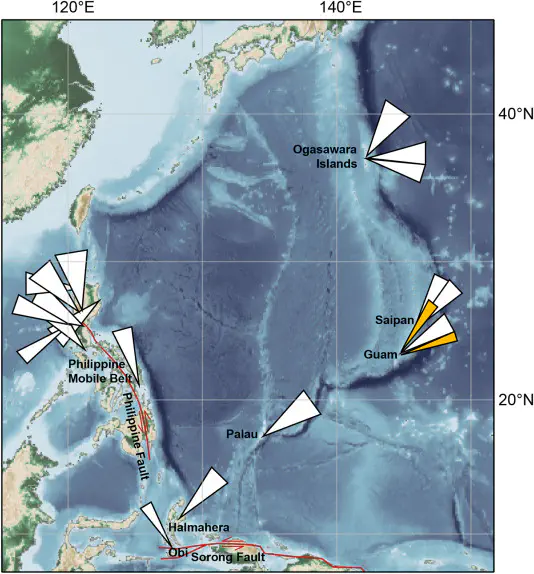A critical reappraisal of paleomagnetic evidence for Philippine Sea Plate rotation
 Map of the Philippine Sea Plate showing declinations in our paleomagnetic data compilation with A95 confidence parachutes.
Map of the Philippine Sea Plate showing declinations in our paleomagnetic data compilation with A95 confidence parachutes.Abstract
The kinematic history of the Philippine Sea Plate (PSP) is crucial for interpreting its geological record related to subduction initiation processes and the paleogeography of the junction between the Paleo-Pacific and Tethyan oceanic realms. However, reconstructing PSP’s kinematic history is difficult because the plate has been surrounded by subduction zones for most of its history. In absence of marine magnetic anomalies to constrain PSP’s motion relative to its neighboring plates, paleomagnetic data may be used as quantitative constraints on its motion. Previous paleomagnetic studies interpreted easterly deflected declinations to infer clockwise rotations of up to 90° since the Eocene. However, rotations inferred from these datasets may also reflect local block rotations related to plate margin deformation. We here re-evaluate to what extent paleomagnetic data from the PSP unequivocally demonstrate plate motion rather than local rotation. To this end, we provide new data from Guam, in the Mariana forearc, and reassess published paleomagnetic data. Our new data from Guam come from two localities in the Eocene, two in the Oligocene, and two in the Miocene. Our compilation assesses data quality against recently defined criteria. Our new results demonstrate that in Guam, declination differences of up to 35° exist in rocks of Eocene age, indicating local rotations. Our compilation identifies both clockwise and counterclockwise rotations from the plate margins, with little confidence which of these would reflect plate-wide rotation. We compiled paleolatitude data from igneous rocks, which we correct for microplate rotation constrained by intra-PSP marine magnetic anomalies and show a northward drift of the PSP of ∼15° since the Eocene, but without a paleomagnetic necessity for major vertical axis rotation. Hence, with the currently available data, rotations of the PSP may be permitted, but are not required. Plate motion is currently better reconstructed from geological constraints contained in circum-PSP orogenic belts.